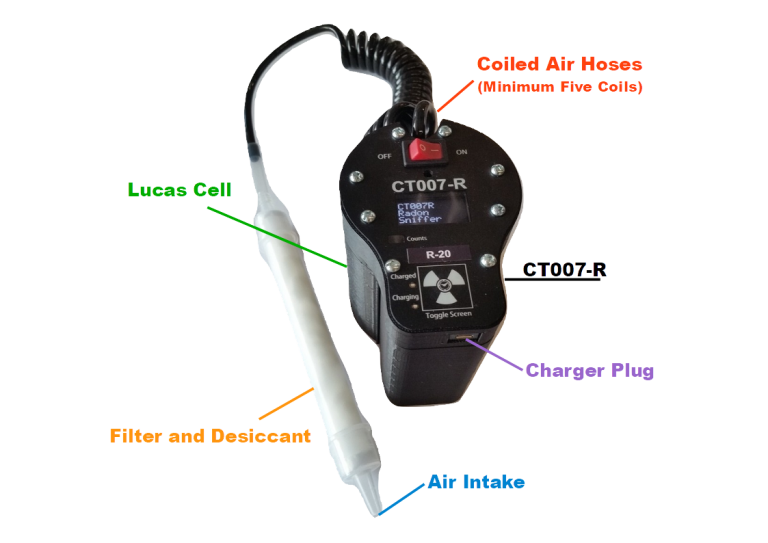Radon Sniffer Operation
Modes of Operation:
Stand-Alone Operation:
Once the CT007-R is powered ON, it starts sniffing: Air is continually pumped through a scintillation cell and the radon concentration in the air is calculated every 3 seconds.
Sniffing mode is ideal for quickly locating where radon is entering a building because the probe can be inserted into a crack in the foundation and if there is radon entering through the crack, you will know in as little as 15 seconds.
In stand-alone mode, the CT007-R Radon Sniffer runs in sniffing mode, using our “Smart” algorithm. Users can press the button to toggle views of the radon activity concentrations either in the 15 second, the 5 minute, or the overall run time average. The screen can also be toggled OFF to save power when the CT007-R is connected to a phone.
Once you plug in the charger, the “Charging” LED turns on if it is not fully charged. If it is fully charged with the charger plugged in, the “Charged” LED will turn on instead.
-
Connected to a Smart Phone:
The CT007-R Radon Sniffer can also connect to smartphones via Bluetooth Low Energy (BLE) for wireless monitoring as well as control purposes. Both iOS and Android system phones are supported.
There are three display modes on the Radon Sniffer app: Smart mode, Standard mode and Timer mode. All modes and display units are switchable on the app. Smart and Standard modes measure the radon concentration averages using different algorithms, as explained below. In Timer mode, CT007-R can be set to count the number of alpha particles for a configurable length of time. Users can also change setting parameters and email themselves the logged data in the menu bar.
On the app, calculations are performed independently from the local CT007-R. Users can switch display modes, units or conversion factors on the fly without affecting the CT007-R. The app is demonstrated in this video.
For more information, please see the user’s manuals below:
Principle of Operation:
The CT007-R uses an internal pump to draw air through a scintillation cell. Before air is drawn into the scintillation cell, any radon progeny in the air is removed by a filter. The Silicon Photomultipliers (SiPM) inside the cell detect the scintillation light from alpha particles emitted by the decay of radon within the cell.

As radon decays inside the cell, the alpha particle emitted hits the wall of the cell, which is coated with scintillation powder, and emits a flash of light. The photomultiplier converts the light into an electronic pulse, which is then counted.
Smart and Standard Modes:
The difficulty with using this principle for measuring radon is that the product of this radon decay is also radioactive. This radon progeny tends to plate out, or stick, on the side of the scintillation cell. The radon progeny continues to emit alpha particles, even after there is no longer radon in the cell. It takes about three hours for radon progeny to decay. In other words, unless one can determine the fraction of the pulses that are due to radon progeny, the time resolution will be quite poor (3 hours).
Smart Mode:
The ‘Smart’ algorithm used by the CT007-R assumes that the first count the detector sees is due to radon gas. This is because radon will pass through the filter and radon progeny will not. It is therefore important to start the unit in an area with a low radon concentration. From the amount of radon gas detected, the devices can calculate how much radon progeny is generated. From that, it calculates the number of counts that will be due to radon progeny in the future because the half lives of radon progeny are well known.
At the next time interval, the device knows the number of counts that are due to radon progeny. By subtracting that number from the gross counts recorded, the number of counts due to radon gas is calculated. From the amount of radon gas, the device again calculates the amount of radon progeny that is generated, and so on. This calculation is repeated every 15 seconds.
Standard Mode:
The ‘Standard’ ( or ‘Non-Smart’) algorithm simply assumes that one third of all counts received are due to radon and the rest are due to radon progeny. This is the mode that most other scintillation cell based radon detectors use for their continuous sampling mode. This is a much simpler calculation and the displayed result will be more stable than in the Smart mode. But, the results are only really valid when radon levels are fairly constant and the instrument has been running for a while.
The local display on the CT007-R is always in ‘Smart’ mode, while the app can enable or disable ‘Smart’ mode by sliding a toggle switch. (Both calculations are performed all the time and the display just switches which result is displayed.)
Use ‘Smart’ mode when you want to detect rapid changes in radon concentration. Use ‘Standard’ mode when you want to see steady values displayed.
The difference in results between the two calculation methods is demonstrated near the end of this video, under controlled conditions, in a radon chamber.

